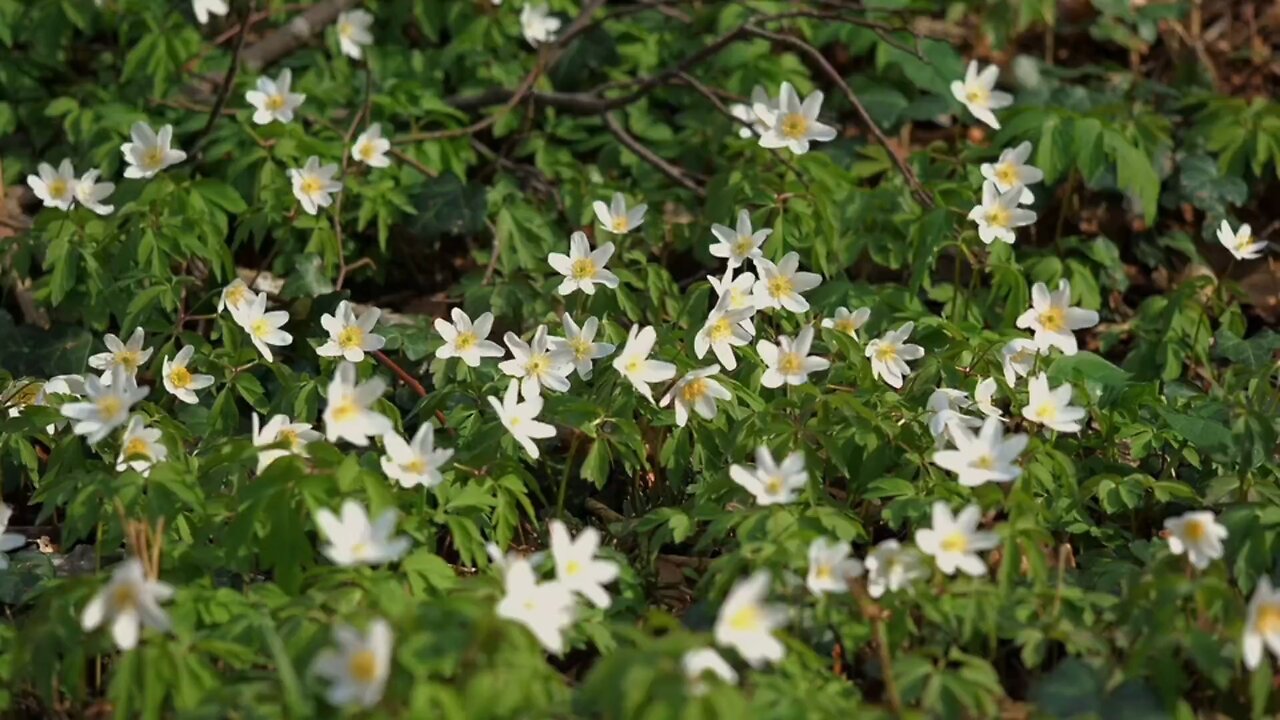Premium Only Content

"Wood Anemone: Nature's Springtime Herald"
The wood anemone (*Anemone nemorosa*) is a delicate and charming wildflower native to Europe and parts of Asia. Here’s an overview of its key characteristics:
### Characteristics:
- **Appearance**: The wood anemone is a low-growing perennial plant, typically reaching a height of 10 to 25 cm. It has slender stems and produces one or more flowers per stem. The flowers are usually white, though they can sometimes have a pink or purple tint. Each flower has six to eight petal-like sepals surrounding a cluster of yellow stamens.
- **Leaves**: The leaves of the wood anemone are deeply divided and typically have a dark green color. They are arranged in a whorl around the middle of the stem, below the flower.
### Habitat:
- **Woodland Plant**: As its name suggests, the wood anemone is commonly found in woodlands and shady areas, particularly in deciduous forests. It thrives in humus-rich, well-drained soils and is often seen carpeting the forest floor in early spring before the trees fully leaf out.
- **Seasonality**: The wood anemone is one of the first flowers to bloom in spring, typically flowering from March to May. After flowering, the plant dies back, leaving no trace above ground for the rest of the year.
### Ecological Role:
- **Indicator of Ancient Woodland**: In some regions, the presence of wood anemones is used as an indicator of ancient woodland, as these plants spread slowly and tend to thrive in long-established forests.
- **Pollination**: The flowers of the wood anemone are primarily pollinated by bees and other insects. However, they can also self-pollinate if pollinators are scarce.
### Cultural and Historical Significance:
- **Folklore**: The wood anemone is associated with various folklore and myths. In some traditions, it is believed to bring luck or is associated with the arrival of spring.
- **Medicinal Uses**: Historically, parts of the plant were used in traditional medicine, though it is mildly toxic and should be handled with care.
### Conservation:
- **Status**: The wood anemone is generally not considered threatened, though habitat loss due to deforestation and land development can impact local populations.
This beautiful plant is often appreciated for its early spring blooms, adding a touch of brightness to woodlands after the winter months.
-
 30:25
30:25
Standpoint with Gabe Groisman
1 day agoDemocrats Are Stalling Trump Appointments with Senator Rick Scott
80.4K15 -
 1:00:24
1:00:24
The StoneZONE with Roger Stone
7 hours agoAnthony Fauci’s Brutal History Of Animal Torture Exposed! | The StoneZONE w/ Roger Stone
53.7K18 -
 1:03:38
1:03:38
Man in America
8 hours agoUSAID Corruption, $21 TRILLION Missing, & the End of the US Global Empire?
36.3K27 -
 56:38
56:38
Flyover Conservatives
8 hours ago6 Steps to Take Advantage of Trump’s New Golden Age! - Clay Clark | FOC Show
26.5K2 -
 1:15:25
1:15:25
Glenn Greenwald
8 hours agoTulsi and RFK Jr. Approved by Key Senate Committees; Trump Meets Netanyahu: Wants to Cleanse Gaza; Pro-Palestinian Group Suspended at UMich | SYSTEM UPDATE #402
85.8K101 -
 1:43:57
1:43:57
Danny Polishchuk
8 hours agoThe Funniest Call In Show On Earth - Live From New York City's Best Comedy Club
48.6K1 -
 1:41:13
1:41:13
megimu32
8 hours agoON THE SUBJECT: Will the Super Bowl Be WOKE??!
37.8K7 -
 1:18:26
1:18:26
Redacted News
9 hours agoBREAKING! USAID Created and Funded COVID-19 Virus and Bioweapons, RFK and Tulsi pass major hurdle
158K213 -
 50:54
50:54
Candace Show Podcast
9 hours agoBecoming Brigitte: Gaslighting The Public | Ep 1
207K227 -
 4:41:05
4:41:05
Right Side Broadcasting Network
14 hours agoLIVE: President Trump Holds Press Conference with Israeli PM Benjamin Netanyahu - 2/4/25
229K100